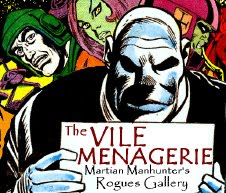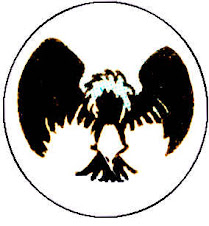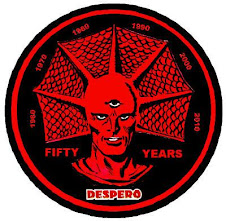
As it turned out, the murder of J'Onn J'Onzz was surely among the shortest-lived deaths in a comic book history partially defined in popular culture by its genre-specific impermanence. Pronounced deceased on May 28, 2008, the Final Crisis-branded coda mini-series starring the villain Human Flame (who had sought Martian Manhunter's death by Libra) was still being released when Blackest Night debuted. On July 15, 2009, 413 days from his expiration date, J'Onn J'Onzz of Mars was ordered to "RISE" and join the hateful undead Black Lantern Corps. Another 259 days later, a dozen "White Lantern" rings compelled their bearers to "LIVE" unto a Brightest Day. The Alien Atlas co-starred in the bestselling year-long biweekly ensemble maxi-series and seemed poised for another chance at a solo ongoing.
Comic book continuity is a sort of gentlemen's agreement, where readers suspend disbelief to allow for all the stories being told at a particular publisher to have "happened" as one overarching cohesive universe. A broad general audience expecting entry-level reading with every comic purchase had no use for that sort of thing, but as their attention and dimes shifted to television, the nerds living vicariously through a four-color existence demanded it. There was a loose coexistence until 1986, when fears of insolvency and irrelevance pushed DC toward a more contemporary and "Marvel" type of tight interrelationships. DC was always a square peg in a round hole in that regard, but aside from intermittent fixer-uppers and a few "hard" reboots, you could argue that there was a through line from their publishing beginnings to the present.
Then, Flashpoint. DC was tired of being eternally #2, and the slow steady decay of an ever narrowing market necessitated the sensationalism of a "New 52"-title strong across-the-board-of-the-Titanic restarting of their history. Talent-wise, DC just rearranged the deck chairs, and they were so indecisive that the public wasn't sure it even was a complete restart until months into the relaunch, but sure enough it seems to have been. Yes, still weasel words over seven years later.
Despite all the groundwork for spin-offs laid down in Brightest Day, none of it led anywhere, and we were now in a universe where the Martian Manhunter was at a halfway point between familiar super-hero uncle and scary inscrutable alien who had only the briefest association with the Justice League before seemingly, violently betraying them... To join, of all things, Wildstorm's integrated and reconfigured Authority (though back to being called Stormwatch to preserve future branding opportunities.) No need to go into too much detail, because the arrangement lasted less than a year before J'Onn erased the members' minds about his ever having served alongside them. Next up, a new incarnation of Justice League of America (various anti-heroes, second-stringers, and rehab attempts) manufactured by Amanda Waller to "take out" the real Justice League (essentially the 1960s founders with Cyborg replacing J'Onn.) I won't go too far into them either, since despite launching with FIFTY-THREE variant covers that title lasted barely more than a year. Next up, Justice League United, the de facto JLCanada. Seventeen issues. Fifty-two covers total. Martian mulligans. He's back on the main team, currently, following a "Rebirth" that seems to have let some of the old continuity back in.
There was finally another "ongoing" series (three years too late) and a maxi-series launched late in the decade, both a dozen issues of "everything you thought you knew was wrong, but you apparently thought you knew something from this book, which won't stick, so also wrong." Eh, nobody reads comics anymore. But the Cyborg swap also meant the Martian Marvel was no longer carried into DTV animation or feature films alongside the Justice League. But you saw Justice League, so whose to say which pro/con column that falls into. Martian Manhunter still gets lighter play in animation, too part in successful video games like Injustice 2, and has been a series regular on the CW TV show Supergirl since 2015. By the end of the decade, that will have seen over 100 episodes. It's not a billion dollars at the box office, but fish jokes aside, J'Onn is no Aquaman. And it sure beats being a zombie super-villain.
2010
Justice League: Cry for Justice #7 (April, 2010) DC Holiday Special '09 #1
BRIGHTEST DAY PART 1
#0, #1, #2, #3, #6, #7, #8
Green Arrow #4
BRIGHTEST DAY PART 2
#9, #11, #12, #15, #18, #19, #22
2011
Flashpoint #1
DC Retroactive: JLA - The '90s #1
Stormwatch #1
Stormwatch #2
2012
Legion Lost #5
STORMWATCH
#3, #4, #5, #6, #7, #8, #9
Superman Annual #1
2013
Justice League #17
JUSTICE LEAGUE OF AMERICA
#1, #2a, #2b, #3
2015
All-Star Section Eight #3
MARTIAN MANHUNTER
#1, #2, #3,#4, #5, #6
2017
Doomsday Clock #1-12
Current as of 5/4/19






























2 comments:
What do you think of J´onn actual main role in Justice League, and his relationship with Hawkgirl and new son of both Shayne? and/or his current solo comic book series
I don't think it makes much sense. It's like Barry Allen and Jessica Cruz where they have small moments but nothing substantial.
Post a Comment